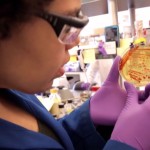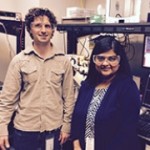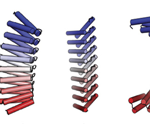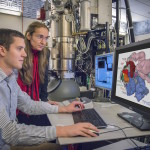 Currently in its ninth year of operation, JBEI has made remarkable scientific progress toward the development of renewable bioenergy solutions. Fundamental to JBEI’s mission is also its commitment to preparing the next generation of scientists, promoting the benefits of biofuels and expanding broad interest in science. In light of this commitment, JBEI has debuted nine short videos in a series entitled “Bioenergy Research @ JBEI”. To watch the videos visit JBEI’s YouTube channel.
Currently in its ninth year of operation, JBEI has made remarkable scientific progress toward the development of renewable bioenergy solutions. Fundamental to JBEI’s mission is also its commitment to preparing the next generation of scientists, promoting the benefits of biofuels and expanding broad interest in science. In light of this commitment, JBEI has debuted nine short videos in a series entitled “Bioenergy Research @ JBEI”. To watch the videos visit JBEI’s YouTube channel.
Exploring the Repeat-Protein Universe
Naturally occurring proteins—chains of amino acids that fold into functional, three-dimensional shapes—are believed to represent just a small fraction of the universe of all possible permutations of amino-acid sequences and folds.  How can we begin to systematically sift through those permutations to find and engineer from scratch (de novo) proteins with the characteristics desired for medical, environmental, and industrial purposes? To address this question, a team led by researchers from the Institute for Protein Design at the University of Washington have published a landmark study that used both protein crystallography (Beamlines 8.2.1 in the Berkeley Center for Structural Biology and 8.3.1) and small-angle x-ray scattering (SAXS; SIBYLS Beamline) at the ALS to validate the computationally designed structures of novel proteins with repeated motifs. The results show that the protein-folding universe is far larger than realized, opening up a wide array of new possibilities for biomolecular engineering. Read the ALS Science Highlight.
How can we begin to systematically sift through those permutations to find and engineer from scratch (de novo) proteins with the characteristics desired for medical, environmental, and industrial purposes? To address this question, a team led by researchers from the Institute for Protein Design at the University of Washington have published a landmark study that used both protein crystallography (Beamlines 8.2.1 in the Berkeley Center for Structural Biology and 8.3.1) and small-angle x-ray scattering (SAXS; SIBYLS Beamline) at the ALS to validate the computationally designed structures of novel proteins with repeated motifs. The results show that the protein-folding universe is far larger than realized, opening up a wide array of new possibilities for biomolecular engineering. Read the ALS Science Highlight.
Unlocking the Secrets of Gene Expression
Using cryo-electron microscopy (cryo-EM), Lawrence Berkeley National Laboratory faculty scientist Eva Nogales and her team have made a significant breakthrough in our understanding of how our molecular machinery finds the right DNA to copy, showing with unprecedented detail the role of a powerhouse transcription factor known as TFIID. Read more at the Berkeley Lab News Center.
Doudna receives Canada’s Gairdner Award as CRISPR sweeps field
Jennifer Doudna, a faculty scientist in the Molecular Biophysics & Integrated Bioimaging Divison, as well as professor of molecular and cell biology and of chemistry at UC Berkeley, will share the 2016 Canada Gairdner International Awards with four others for their roles in discovering and re-engineering the CRISPR-Cas9 system to create today’s most-talked-about genetic tool. Read more at UC Berkeley NewsCenter.
Biosciences Researchers Participate in Lab-Corps Program Training
 The Office of Energy Efficiency and Renewable Energy’s Lab-Corps program has announced a second round of training for entrepreneurial teams at the national labs. Lab-Corps aims to accelerate the transfer of clean energy technologies from the national labs to the marketplace by training and empowering national lab researchers to successfully transition their discoveries into high-impact, real world technologies in the private sector. The training which involves 14 project teams from seven DOE national labs began this week in Golden, Colorado. The rigorous seven-week training follows the path of a typical start-up accelerator.
The Office of Energy Efficiency and Renewable Energy’s Lab-Corps program has announced a second round of training for entrepreneurial teams at the national labs. Lab-Corps aims to accelerate the transfer of clean energy technologies from the national labs to the marketplace by training and empowering national lab researchers to successfully transition their discoveries into high-impact, real world technologies in the private sector. The training which involves 14 project teams from seven DOE national labs began this week in Golden, Colorado. The rigorous seven-week training follows the path of a typical start-up accelerator.
- « Previous Page
- 1
- …
- 191
- 192
- 193
- 194
- 195
- …
- 213
- Next Page »
Was this page useful?






